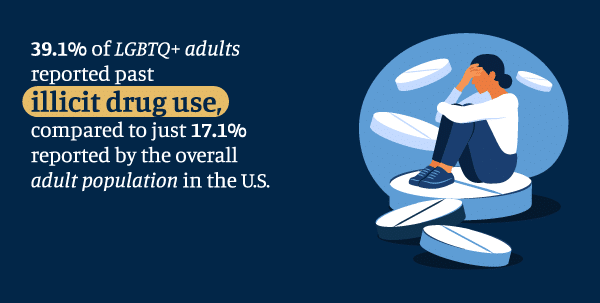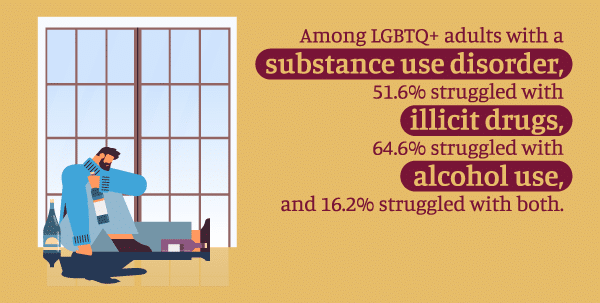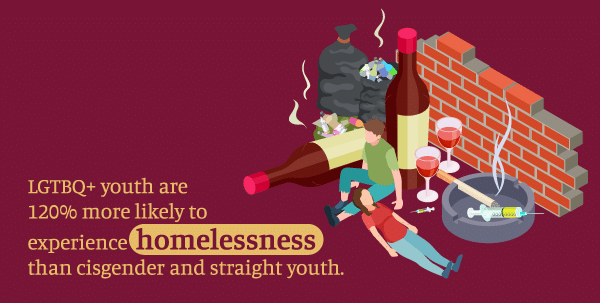LGBTQ+ Guide for Addiction Treatment
This article is a provider’s guide to substance use treatment for LGBTQ+ individuals.

LGBTQ+ Guide for Addiction Treatment
This article is a provider’s guide to substance use treatment for LGBTQ+ individuals.
Table of Contents
The LGBTQ+ Community and Addiction
LGBTQ+ substance abuse statistics show a critical need to improve treatment for LGBTQ+ clients and raise awareness about the issues that are unique to this group of individuals. Providers must be sensitized to these challenges to provide culturally competent, effective treatment and improved outcomes.
A Brief Understanding of LGBTQ+
What Does LGBTQ+ Stand For?
The acronym “LGBTQ” stands for lesbian, gay, bisexual, transgender, queer, and questioning.
The “+” represents those individuals who identify as another sexual identity, including pansexual, two-spirit, and non-binary individuals. The acronym represents a diverse range of gender identities and sexualities.
Challenges the LGBTQ+ Community Faces
There are many challenges the LGBTQ+ community faces, some of which include:
- Discrimination or stigmatization
- Hate crimes, emotional abuse, and threats
- Loss of employment
- Heterosexism
- Cultural issues
- Legal issues
- Lack of accessibility to care
While federal and some state laws protect recovering substance users from discrimination, LGBTQ+ populations do not receive the same protection in many areas of the country.
Substance Use as a Coping Mechanism
Some individuals turn to substance use to cope with these challenges. That being said, substance use, especially alcohol use, has a heavy influence on the social life of some segments of the LGBTQ+ community. Providers must recognize that this use results from discrimination and prejudice and is not a consequence of an individual’s sexuality. Providers may falsely believe that sexual identity is the cause of substance use.
Treatment Barriers
Some LGBTQ+ members have difficulty trusting others and find it uncomfortable or difficult to access treatment services. What’s more, many substance use treatment programs are not equipped to meet the needs of the LGBTQ+ population.
Many members of the community report feeling anxious, angry, depressed, fearful, and isolated during treatment. In addition, providers might be antagonistic toward or insensitive to these individuals, creating barriers between effective treatment and the LGBTQ+ community.
Common Co-occurring Disorders in the LGBTQ+ Community

As a result of the stressors and challenges, LGBTQ+ populations are at an increased risk for various behavioral health issues.1 This is in addition to the heightened risk of substance use, making way for co-occurring disorders.
An individual may be diagnosed with co-occurring disorders when a substance use disorder is present along with a mental disorder. More than nine million people in the U.S. had substance use disorders along with mental illness in 2018.2
Common co-occurring disorders in the LGBTQ+ community include:2
- Major depressive disorder
- Generalized anxiety disorder
- High levels of stress
- Suicide attempts or self-harming tendencies
Individuals in the LGBTQ+ community are also more prone to suffering from eating disorders, mood disorders, and other psychiatric issues. In addition, some may suffer from other serious health problems that include sexually transmitted diseases like HIV/AIDS and hepatitis.3 This may further interfere with the ability or desire to seek treatment.
Common Drugs Within the LGBTQ+ Community

Although federally funded surveys have only recently begun asking about gender identification and sexual orientation, LGBTQ+ substance abuse statistics show that sexual minorities have higher rates of substance misuse than those who identify as heterosexual. They also tend to have more severe substance use disorders.4
This observation is especially relevant to transgender substance abuse. It is clear that the need for more accessible, specialized LGBTQ+ addiction treatment is pressing.
Six of the most commonly used substances among sexual minorities include:5
- Tobacco
- Alcohol
- Marijuana
- Heroin
- Methamphetamines
- Opioids
Internalized Issues
When many members of this community suffer from internalized homophobia, they self-identify with anti-gay stigmas. They may be unable to feel comfortable or safe as a result, and self-loathing can occur. Some individuals then turn to alcohol and other substances to silence negative thoughts to feel at ease living as their true selves.
The Substance Abuse and Mental Health Services Administration reported that in 2019, 7.6 million adults in the LGBTQ+ community had a mental illness and/or a substance use disorder. This represents a disturbing and shocking increase of 20.5% over the previous year’s report. LGBTQ+ substance abuse statistics also show increasing rates of marijuana use within the LGBTQ+ population and an increase in opioid misuse in some age groups.5
A Discussion on Challenges Facing the LGBTQ+ Community
Addiction Counseling in Specialized Programs

Specialized LGBTQ+ addiction treatment shows better outcomes for clients compared to non-specialized programs. Research shows that LGBTQ addiction treatment must address unique factors in the lives of these patients, including family issues, violence, homophobia/transphobia, and social isolation.6
Addiction treatment for LGBTQ+ individuals can be powerfully effective across various modalities and delivery options. Some of the specialized LGBTQ+ addiction treatment therapies shown to be most effective include:6
- Cognitive-behavioral therapy (CBT)
- Individualized treatment planning
- Individual counseling
- Group counseling
- Family counseling
Problems arise when addiction recovery treatment is not specialized. That’s why groups must be inclusive and encourage each patient to discuss relevant issues and concerns.
In treatment groups that are not specialized, other clients (in group counseling, for example) might have negative attitudes toward LGBTQ+ individuals.
Individual Counseling for LGBTQ+ Addiction Treatment
In specialized LGBTQ+ treatment, providers must assess the patient’s substance use in order to develop individualized treatment plans to match the level of care and service each patient requires. Important considerations are the type and amount of a substance used, the danger and complications of withdrawal, and the impact of stressors. Providers must also assess family history and dynamics as well as social environments like school or the workplace.
Group Counseling for LGBTQ+ Addiction Treatment
Providers must ensure that all other group participants understand that homophobia will not be tolerated. In mixed groups, it must be the LGBTQ+ patient who decides whether issues relating to their sexual orientation be discussed.
Providing specialized LGBTQ+ addiction treatment eradicates the mixing of clients and diminishes the likelihood that homophobia will be an issue. At the same time, a mixed group with a culturally competent provider can nurture an effective healing experience as patients gain support from heterosexual peers.
LGBTQ+ Addiction Treatment
Substance use compromises good judgment and can elicit dangerous behaviors, potentially leading to illness, disease, violence, and even greater substance use problems within the LGBTQ+ community. Some who seek LGBTQ+ treatment for addiction have been victims of hate crimes or domestic violence and may have experienced neglectful health care.
Therefore, it’s imperative that LGBTQ+ addiction treatment providers screen for co-occurring mental health disorders, poor dental health, malnutrition, STDs, LGBT abuse, and liver disease. This way, program administrators can provide comprehensive, effective treatment.7
Common Treatment Programs
The most common programs for addiction treatment that help support recovery include:
- Detox programs
- Short-term residential rehab programs
- Long-term residential rehab programs
- Short-term outpatient rehab programs
Many LGBTQ+ individuals, especially transgender persons, may be reluctant to use mainstream healthcare services because of the historical marginalization of some health professionals. This is especially true for those who could benefit from transgender substance abuse treatment. In addition, many professionals have wrongly labeled minority sexual orientations as pathological or deviant.
The Role of the LGBTQ+ Treatment Provider

Within all of the above-stated detox and rehab programs, providers must respect the client’s frame of reference and maintain professional objectivity at all times. They must recognize the importance of collaboration with the LGBTQ+ client and the need for flexibility and adjustment within personalized treatment programs. Providers must be nonjudgmental and respectfully accept the behavioral, cultural, and social values of the LGBTQ+ client.
Providers are responsible for adhering to ethical and professional standards and monitoring themselves, working through their own feelings about LGBTQ+ clients. They must not overidentify with them, meet their own needs through clients, or react to clients simply due to their own unresolved personal issues.
Heterosexism in Addiction Treatment
Providers must be sensitive to and aware of heterosexism within addiction treatment groups and programs. Heterosexism is a prejudice comparable to sexism and racism that denies, denigrates, or stigmatizes any form of activity or behavior that is not heterosexual.
Some examples of heterosexism that should not be tolerated in LGBTQ+ addiction treatment settings include:7
- Jokes and cynical comments about non-heterosexual behaviors
- LGBTQ-bashing conversations
- A lack of openly LGBTQ+ personnel
- Jokes about openly LGBTQ+ staff members
- A lack of inclusion of LGBTQ+ family members or partners in the treatment process
Impact of Hetersexism
LGBTQ+ addiction treatment providers must remember that non-heterosexual patients don’t know the reaction they will receive when they mention their sexual orientation. Many fear backlash resulting from antigay bias, internalized homophobia, and heterosexism.
Most, if not all, addiction treatment programs likely have LGBTQ+ members, but staff members and providers may not be aware of it. This possibility makes it even more critical that providers adhere to the codes of ethics and ensure no heterosexism occurs in the treatment setting.
Dangers of Heterosexism
Heterosexism instills shame in many individuals and causes them to internalize homophobia. They can then turn to self-blame or anger directed inward or outward, resulting in destructive behavior patterns, substance use, a victim mentality, and other destructive actions and thoughts.
Disclosure of an individual’s sexual orientation can also lead to denial of housing, social services, and employment. Even in states that prohibit discrimination based on sexual orientation, LGBTQ+ individuals are still actively denied protection.
Benefits of an LGBTQ+ Addiction Treatment Program

LGBTQ+ patients often rely on the personal experiences and opinions of those they trust when selecting a provider or addiction treatment options. They usually trust other LGBTQ+ persons more than the general medical establishment when making decisions regarding treatment.
LGBT treatment for addiction and recovery must focus on healing. Much of what is taught by institutions does not reflect the personal experiences of this community. When providers use appropriate materials in addiction treatment that acknowledge the LGBTQ+ community, the benefits are more empowering.8
Overturning Negative Internalized Emotions
By providing specialized LGBTQ+ addiction treatment, patients will feel like they are a part of the majority rather than the minority. They will find support as they are surrounded by peers who understand and validate their points of view, unique hurdles and challenges, and personal experiences.
LGBTQ+ affirmative treatment goes above and beyond mere acceptance—it focuses on reaching out while thoughtfully addressing community-specific challenges. In these programs, the entire LGBTQ+ community is at the center of treatment, validating a patient’s identity as providers investigate the core drivers of substance use. Some of the core drivers of substance use focused on during affirmative addiction treatment include:
- Violence
- Trauma
- Harassment
- Discrimination
- Family issues
When physical and mental health care for the LGBTQ+ population are coordinated, patients are more likely to complete treatment and remain substance-free afterward. Affirmative treatment environments that promote inclusivity and acceptance foster feelings of safety, helping patients embrace treatment on a higher level.
Since these environments also offer greater support for client treatment adherence and follow-through, LGBTQ+ recovery can be complete and long-lasting.
Handling “Coming Out” Trauma
Much of the trauma that LGTBQ+ individuals face begins even before coming out. For example, they often suffer from severe anxiety and stress over the reactions of family members, friends, schoolmates, and co-workers long before they reveal their orientation or gender identity.
A Further Look at Coming Out
Trauma-Informed Care
Trauma-informed care is critical as a framework for providers who want to create a safe treatment setting for LGBTQ+ persons. Once the environment is safe, other principles like collaboration, empowerment, and trustworthiness can build upon the secure foundation.
In a trauma-informed approach to treatment, all aspects of treatment delivery are grounded in an understanding of trauma’s impact on an individual, promoting resilience and healing. This approach has principles that reflect the values, beliefs, and attitudes required to support community members exposed to trauma, including the perceived future trauma that can be associated with coming out.9
Confidentiality and Comfortability Expressing Sexual Orientation
Specialized treatment programs geared toward LGBTQ+ treatment must protect the confidentiality of clients. The consequences of an inappropriate or insensitive disclosure can be devastating and range from job termination to legal family issues and more.
By incorporating specialized, trauma-informed LGBTQ+ treatment plans, providers establish safety as a foundation for healing, and with it, they secure the patient’s trust and confidence. Trauma is one of the most challenging LGBTQ+ community issues. It contributes to anxiety and abuse of substances, threatening the effectiveness of residential treatment and recovery.9
When providers overlook trauma as one of the most significant problems within the LGBTQ+ community, treatment effectiveness suffers, as does the patient.
A shared understanding of the unique stressors that LGBTQ+ clients face is one of the greatest benefits of an LGBTQ+ treatment program. Patients learn how to cope with the extra challenges associated with their sexual orientation or gender identity and ultimately gain control over substance use while strengthening their own identity and self-worth.
Resources
- https://www.samhsa.gov/data/sites/default/files/NSDUH-SexualOrientation-2015/NSDUH-SexualOrientation-2015/NSDUH-SexualOrientation-2015.htm
- https://dualdiagnosis.org/mental-health-and-addiction/
- https://americanaddictioncenters.org/lgbtqiapk-addiction/why-substance-abuse-is-higher-within-the-lgbtq-community
- https://pubmed.ncbi.nlm.nih.gov/16490677/
- https://store.samhsa.gov/sites/default/files/SAMHSA_Digital_Download/sma12-4104.pdf
- https://www.lgbthealtheducation.org/wp-content/uploads/2016/11/Keuroghlian-Addictions-Webinar.pdf
- https://healthysafechildren.org/sites/default/files/Trauma_Informed_Approach_LGBTQ_Youth_1.pdf
- https://pubmed.ncbi.nlm.nih.gov/17366131/
- https://www.psychologytoday.com/us/blog/trauma-informed-living/201910/coming-out-queer















